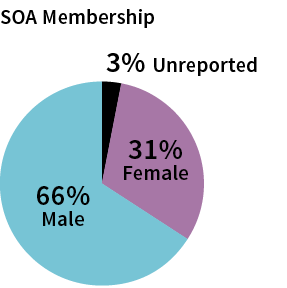Championing Diversity and Inclusion
Q&A with Craig Reynolds, FSA, MAAA
February/March 2019Craig Reynolds, FSA, MAAA, is a principal and consulting actuary, and a lead of the Life Insurance consulting practice of Milliman’s Seattle office. Many actuaries know Craig from his numerous volunteer roles with the Society of Actuaries (SOA), including serving as a past president of the SOA. In 2018, Craig was the chair of the SOA’s Inclusion and Diversity Committee and the Joint Committee on Career Encouragement and Actuarial Diversity (JCCEAD or JC), a joint SOA and Casualty Actuarial Society (CAS) Committee on actuarial diversity. As a vocal leader and tireless promoter of diversity in the actuarial profession, Craig has led many initiatives advocating for and improving diversity and inclusion both within and outside of the SOA. I recently sat down with Craig and discussed his career and passion for a more diverse and inclusive actuarial profession.
How did you start your personal involvement in Diversity and Inclusion (D&I) programs at your workplace and at the SOA?
A: My first experience with D&I was through the SOA rather than through Milliman. Around five or six years ago, I volunteered to serve on the JCCEAD to see what I could do in this field. There were two things that inspired me to do that.
One was John Robinson, FSA, MAAA, FCA, who currently works for the Minnesota Department of Insurance. John is from the Caribbean, and he happens to be black. John served on the SOA Board with me and helped me think about the organization not being as diverse as it should be. John presented to the Board on this topic, and what he said really struck a chord in me. I realized that this is an area where the organization could and should do better, and it will make the profession stronger if we succeed.
 The other angle is that my daughters are now 23 and 25 years old, and they are entering the workforce. This made me look around at our profession and realize that there aren’t enough women. We have an overall membership that is barely more than 30 percent female. While this is much better than many science, technology, engineering and math (STEM) professions, we’re certainly lagging behind other professions significantly, like accounting and the medical fields—they’re both around 50 percent female. We must attract more women to the profession and foster an environment inclusive to leadership for everyone. I would like to see both of those things happen. We want more women running for SOA leadership positions and reaching leadership roles in insurance companies and consulting firms. The SOA supports industry initiatives that further that goal.
The other angle is that my daughters are now 23 and 25 years old, and they are entering the workforce. This made me look around at our profession and realize that there aren’t enough women. We have an overall membership that is barely more than 30 percent female. While this is much better than many science, technology, engineering and math (STEM) professions, we’re certainly lagging behind other professions significantly, like accounting and the medical fields—they’re both around 50 percent female. We must attract more women to the profession and foster an environment inclusive to leadership for everyone. I would like to see both of those things happen. We want more women running for SOA leadership positions and reaching leadership roles in insurance companies and consulting firms. The SOA supports industry initiatives that further that goal.
“Cultivate a diverse membership” was introduced in the SOA’s 2017–2021 Strategic Plan. What was the process of developing the Strategic Plan and including D&I initiatives?
A: The SOA formed an Inclusion and Diversity Committee (IDC) a few years back and released a diversity statement. It says diversity is important to the organization and that we welcome people from all backgrounds:
The Society of Actuaries (SOA) best fulfills its mission when it is diverse and inclusive of all individuals. Openness to and acceptance of diverse perspectives, cultures and backgrounds helps to attract the best talent and ensures the overall inclusivity of the actuarial profession.
The SOA welcomes the membership and participation of all individuals, regardless of race, ethnicity, religion, age, gender, sexual orientation, gender identity or expression, disability, or national origin.
Once we adopted this philosophy for the organization, we needed to take action. We included D&I in the Strategic Plan as a direct recognition that our organization is stronger when we have a diverse membership. We received unanimous support from the Board. The debate is never about whether we should be working on this, but rather how to start.
Most of us would say our profession is a meritocracy—we have an exam system to make sure you’re fit to be an actuary. Most employers use the exam system to determine what level to place people in the firm. And some people would say that’s all we need to do—have a race-blind and gender-blind process to get people into the profession, and then our job is done. I disagree with that on several fronts. One of the key issues is that we need to have the right people attempting these exams. There is a large segment of the population that doesn’t know about our profession.
One of the barriers that our 2017 research study found is that the awareness of the actuarial profession at the college level among non-Latino and non–African-American students is twice as high as it is for Latino and African-American students. That tells me that we have work to
do to make sure that anyone who might be good at our profession knows about it. Currently, the SOA is leading a task force with other actuarial organizations and employers to address this lack of awareness. It is a big play and, if done well, we expect to be reporting actual progress back to members in the coming years instead of just talking about it.
Many companies, especially large insurance companies and consulting firms, have their own D&I programs. Can we rely on the employers to address these issues? Why does the SOA need to work on this?
A: First of all, I’m glad employers have those programs. Most company-sponsored D&I programs are about the firm as a whole and not about the actuarial positions in particular. I’m simplifying things, but a company might have one department that is 20 percent African-Americans and another one that has zero African-Americans and think that the company is doing well with 10 percent in total. The problem is not all positions are equal. We know that the actuarial path is a common route for growing into a leadership role in many organizations. The composition of our profession should reflect the environment in which it operates.
Second, many actuarial jobs are with small firms. Some small companies have little ability to address D&I. And when they do, they’re especially vulnerable to the fact that they have little leverage to grow the pipeline. They can try their best to have a nondiscriminatory hiring practice. But attracting new people from underrepresented groups will require a concerted broad-based effort—and the SOA’s help.
What are the current focus areas for JCCEAD and IDC?
A: We want to maintain D&I as a high-profile and high-impact issue and maintain a high degree of focus of the organization. The JCCEAD, which has been around for quite a while, has three areas of focus. They mentor and provide funding to diversity-focused summer programs for high school students at a number of universities. They attend conferences. We have a booth and send actuaries to several professional conferences to advocate for the profession among students and student-influencers. They partake in outreach and communication to make people more aware of our profession. The BeAnActuary.org website is the key gateway. A Spanish version of this website was launched a couple of years ago as well.
As I mentioned, after completing the Barriers to Entry research study in 2017, the actuarial organizations represented on the JCCEAD and employers have come together to create an awareness campaign for underrepresented high school students, their parents and influencers. This is a natural fit for the talents of the JCCEAD and IDC volunteers.
What about the Math Motivators tutoring program sponsored by The Actuarial Foundation?
A: I think that is the coolest idea the Foundation has come up with in a long time. I’m very excited to see it taking off. It’s running right now in Hartford, Connecticut, partnering with the University of Connecticut; and in Chicago, partnering with DePaul University. These are tremendous programs that bring tutors (actuarial science students and practicing actuaries) into high schools to help students advance their math standing. These are multidimension programs to help kids that may otherwise not get into their college of choice or even graduate high school. It also helps raise the awareness of the actuarial profession, and hopefully some of these kids will go on to become actuaries to help make the profession stronger. There are other cities exploring setting up similar programs with the support from the Foundation. I helped organize a program at Milliman.
This summer, we are going to start a tutoring program at a local high school with the students who have inadequate progress in math. I’m very excited about that. In many cases, the schools whose student population is heavily weighted toward underrepresented minorities also have many low-income students. Those schools are thrilled to have the help. It is a win-win-win-win for the students, faculty and for the employers and actuarial tutors. You can learn more at mathmotivators.org. And thank you to all the SOA members who met and then exceeded the SOA’s challenge to match $64,000 for the program in 2018. We’re ready to do it again in 2019.
How does someone get involved in these various programs at the SOA or with their own employer’s D&I initiatives?
A: One thing they can do is ask for involvement and offer help to human resources and hiring managers. Get involved in your affinity groups. The other thing is to spend time being a mentor or an adviser to aspiring actuaries. Many actuaries have a presence on LinkedIn. I sometimes receive messages asking about how to become an actuary. I strongly encourage people to respond whenever they have an opportunity to take a call like that from prospective actuaries, especially if it’s someone from an underrepresented group.
Connect with the Organization of Latino Actuaries and the International Association of Black Actuaries and find out how you can help mentor students and actuaries. Keep an eye on events like our LGBTQ and Allies reception and D&I-related professional development sponsored by the SOA at major meetings.
Finally, if you work for a large employer, you should think about whether you can organize your employer to provide math tutors to a local high school for the Math Motivators program. I’m looking forward to seeing programs like these grow in the coming years, and I love watching actuaries make that happen.
Copyright © 2019 by the Society of Actuaries, Chicago, Illinois.

